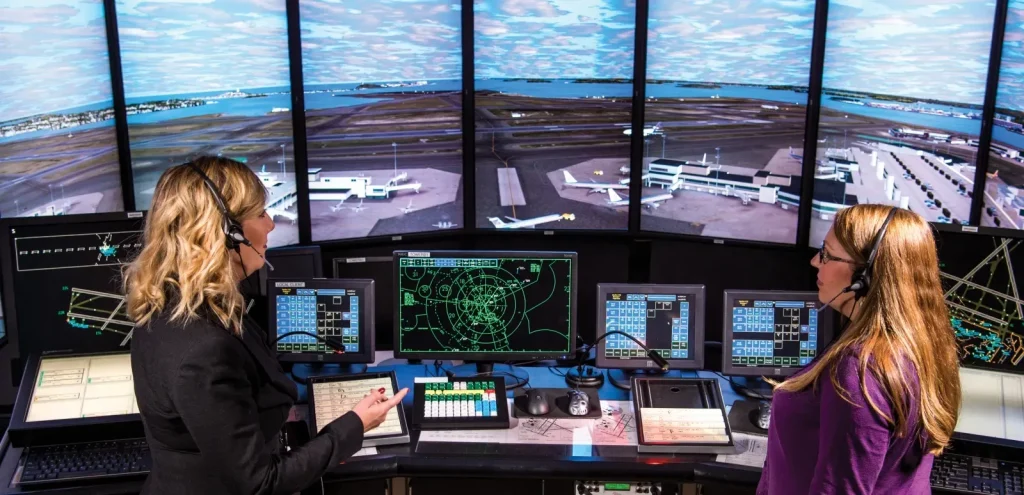U.S. air traffic control is facing unprecedented challenges as staffing shortages and outdated systems strain the ability to manage the nation’s busy skies efficiently. An alarming incident on April 28, where a 90-second equipment failure led to significant flight delays at Newark Liberty International Airport, highlights the urgent need for FAA air traffic control upgrades. With over 45,000 flights operating daily, air traffic controllers are grappling with a staffing crisis that has resulted in a concerning backlog of flight delays, particularly impacting airports like Newark. Coupled with ongoing air traffic safety concerns, the situation calls for immediate attention to improve controller staffing and modernize equipment to prevent future disruptions. As the demand for air travel continues to rise, addressing these issues is critical to ensuring safe and reliable air transportation for all.
The complexities of managing air traffic in the United States have never been more pronounced, particularly as air traffic management systems grapple with chronic shortages in personnel and aging technologies. In light of rising passenger volumes and heightened safety concerns, the urgency to modernize air management infrastructure has intensified. The Federal Aviation Administration (FAA) faces the daunting task of implementing new strategies and enhancements, particularly in light of recent flight disruptions at congested hubs like Newark. With ongoing discussions about enhancing air travel operations, the focus must remain on ensuring that air traffic oversight remains both efficient and safe. As the aviation sector navigates these turbulent times, addressing staffing dilemmas and upgrading technological capabilities will remain paramount.
Understanding U.S. Air Traffic Controller Staffing Challenges
The staffing levels for U.S. air traffic controllers have become a pressing issue over the past decade, with chronic understaffing impacting safety and efficiency. The typical controller typically manages a significant number of flights, especially during peak times. However, as the demand for air travel increases, the insufficient number of trained controllers has led to increased stress and operational difficulties. The average age of air traffic control facilities is 40 years, with outdated technology contributing to inefficiencies that strain the current workforce. This situation highlights the need for urgent reforms and improvements in air traffic controller staffing.
Moreover, the recruitment and retention of air traffic controllers have emerged as significant challenges. Despite numerous applicants—totaling 146,000 over the past eight years—only a small percentage has successfully transitioned into full-time roles. This gap between applications and employment reveals a broader issue within the industry, where the demanding nature of the job and extensive training requirements deter many prospective controllers. Enhanced financial incentives and streamlined training processes are essential to attract more individuals to this critical profession.
The Impact of FAA Air Traffic Control Upgrades
To combat the current air traffic challenges, the Federal Aviation Administration (FAA) is planning a comprehensive upgrade to the U.S. air traffic control system. These upgrades aim to modernize outdated infrastructure and will likely necessitate significant congressional funding. Implementing advanced communication technology and enhancing radar systems could mitigate safety concerns, particularly in busy airspaces like Newark. Upgrading the air traffic control framework is not only vital for efficiency but also crucial for maintaining the safety of air travel across the nation.
These FAA air traffic control upgrades also have a strategic purpose: to streamline operations and reduce the risk of disruptions to services. By investing in new technology and systems, the FAA hopes to enhance coordination among controllers, improve flight tracking capabilities, and manage air traffic flows effectively. Such improvements are essential as air travel demand continues to soar; ensuring that the air traffic control system can handle increased volumes without compromising safety is paramount in this competitive landscape.
Addressing Flight Delays at Newark and Beyond
Newark Liberty International Airport, one of the busiest airports in the U.S., has faced significant flight delays, particularly highlighted during the recent equipment failure incident. The strain on air traffic controllers, aggravated by staffing shortages, forced airlines like United Airlines to make drastic operational adjustments, including cutting flights. This kind of disruption not only affects passengers but also has a ripple effect across airline schedules and profitability, emphasizing the urgent need for reform in air traffic management.
The systemic issues causing flight delays at Newark extend beyond mere staffing concerns. They include outdated technology and limited controller capacities that result in more congested airspace management. Therefore, alongside staffing solutions, the FAA must also look at operational strategies that prioritize real-time data analysis and technology-enabled command systems to facilitate smoother travel experiences. As air traffic continues to swell, ensuring timely and efficient service is essential to restoring confidence in travel and minimizing passenger frustration.
Air Traffic Safety Concerns: A Growing Challenge
Air traffic safety is at the forefront of discussions surrounding the current issues within U.S. air traffic control. Recent incidents, like the tragic helicopter and airplane collision that claimed 67 lives, serve as stark reminders of the consequences of systemic shortfalls. These safety concerns have prompted significant scrutiny of air traffic controller staffing levels and operational integrity. It is critical to understand how chronic understaffing and technological obsolescence can increase the risks of accidents and service failures.
To mitigate these air traffic safety concerns, it is essential that federal agencies, including the FAA, take proactive measures to enhance controller training, increase staffing levels, and invest in new technologies. Implementing rigorous safety protocols and investing in ongoing education for air traffic controllers can help foster an environment where safety is prioritized amid overwhelming operational demands. As the air travel industry continues to evolve, creating a robust safety culture will be essential to maintaining public trust and ensuring the well-being of passengers.
The Urgent Need for Air Travel Staffing Crisis Solutions
The persistent air travel staffing crisis is a multi-faceted issue that requires urgent attention. With travel demands escalating, airlines are struggling to operate effectively, largely due to the ongoing shortage of qualified air traffic controllers. This staffing deficit poses not only logistical challenges but also raises serious concerns about air safety, especially in congested airspace like Newark. As airlines adapt to increased flight schedules, the role of air traffic control becomes even more crucial to maintain order and efficiency.
Addressing the air travel staffing crisis may involve a combination of strategies, including heightened recruitment efforts, improved work conditions for air traffic controllers, and innovative training methods that can expedite the onboarding process. Furthermore, if the FAA can implement better financial packages and career progression opportunities for controllers, it may succeed in attracting and retaining talent that is desperately needed to ensure smooth operations in a rapidly evolving aviation landscape.
Future Prospects for U.S. Air Traffic Control Reform
Looking ahead, the prospects for U.S. air traffic control reform hinge not only on funding and technology advancements but also on a cultural shift within the aviation industry. Policymakers, aviation authorities, and industry leaders must work collaboratively to develop solutions that encompass staffing, safety, and efficiency. This reform would entail investing in modern infrastructure and systems, establishing effective workforce policies, and fostering a work environment that prioritizes air traffic safety and operational excellence.
Moreover, as air traffic volumes continue to rise globally, the urgency for these reforms becomes even more pronounced. The future of air traffic management in the U.S. depends on a multi-pronged approach that blends technological innovation with significant investments in human capital. By addressing these challenges head-on, the aviation industry can transform the current crisis into an opportunity for growth and enhanced safety, ultimately leading to a more reliable air travel experience for all.
Leveraging Technology in Air Traffic Control
Technology plays a pivotal role in addressing air traffic challenges in the U.S. The integration of cutting-edge systems can significantly enhance communication capabilities between air traffic controllers and pilots, reducing the potential for misunderstandings that can lead to disruptions or safety concerns. Innovations such as automated flight tracking and advanced data analytics offer promising solutions to streamline air traffic management, thereby improving overall efficiency and reducing flight delays.
Continued investment in technology will be critical for future air traffic control operations. Enhanced radar systems and real-time data sharing are just two examples of how technology can alleviate some of the burden placed on air traffic controllers. By leveraging these tools, the FAA can ensure that controllers have the support they need to make informed decisions quickly, ultimately leading to safer skies and more predictable flight schedules.
The Role of Air Traffic Controllers in Emergency Situations
Air traffic controllers are at the forefront of managing air traffic effectively, particularly during emergency situations. Their ability to maintain clear lines of communication with pilots and other personnel is vital for ensuring safety in the airspace, especially when unexpected incidents occur. The recent radar failure incident serves as a stark demonstration of how quickly normal operations can be compromised and the immense pressure placed on controllers to navigate such crises with limited resources.
Effective training and crisis management strategies for air traffic controllers are essential for building resilience within the system. As part of their ongoing development, controllers must engage in simulation exercises designed to prepare them for unexpected events. Such training will not only empower them with the skills to handle emergencies but will also help mitigate the anxiety that can accompany equipment failures or other unforeseen challenges in an already strained environment.
Enhancing Collaboration Across the Air Traffic Ecosystem
Collaboration among various stakeholders in the aviation industry is key to addressing the ongoing challenges in air traffic management. From the FAA to airline operators and airport authorities, all parties must work together to develop a cohesive strategy that prioritizes safety, efficiency, and personnel well-being. By fostering open channels of communication and transparency, the industry can better respond to staffing crises and other operational challenges that affect air traffic control.
This collaborative approach will also benefit from harnessing input from current air traffic controllers, whose firsthand experiences can shape policies and reforms that directly influence their work environment. Moreover, engaging with aviation experts and researchers can lead to innovative solutions that incorporate technological advancements and operational best practices, ultimately enhancing the robustness of the U.S. air traffic control system.
Frequently Asked Questions
What are the main challenges facing U.S. air traffic control today?
U.S. air traffic control faces significant challenges, primarily due to chronic understaffing, aging infrastructure, and technology inadequacies. The air traffic controller staffing crisis has led to increased flight delays, particularly at busy airports like Newark Liberty International Airport, which recently experienced over 1,500 delays due to communication outages.
How does air traffic controller staffing affect flight delays at Newark?
Air traffic controller staffing directly impacts flight delays at Newark, as the lack of available controllers can lead to congestion and strain on operations. Recent incidents have shown that due to staffing shortages, Newark faced over 1,500 flight delays, prompting airlines like United to cut flights to manage the load effectively.
What is the FAA doing to improve U.S. air traffic control systems?
The FAA is working on critical upgrades to the U.S. air traffic control system, which involves modernizing aging equipment and improving communication protocols. These FAA air traffic control upgrades aim to enhance safety and efficiency in managing the 45,000 flights handled daily, especially in high-traffic areas.
What are the safety implications of the air traffic safety concerns in the U.S.?
Air traffic safety concerns in the U.S. arise from the combination of staffing shortages and outdated technology. Recent incidents, including a tragic aircraft collision, highlight the urgent need for improved safety measures within air traffic control, reinforcing the importance of hiring more controllers and upgrading equipment.
How is the air travel staffing crisis impacting airline operations?
The air travel staffing crisis is significantly impacting airline operations by leading to an increased number of flight delays and cancellations. With air traffic controllers’ positions hard to fill, airlines are challenged to maintain their schedules, as seen with United Airlines cutting 35 flights daily due to operational strain.
What solutions are being proposed to address the U.S. air traffic control staffing crisis?
Proposed solutions to address the U.S. air traffic control staffing crisis include increasing financial incentives for controllers, enhancing recruitment efforts, and investing in technology upgrades. These initiatives are aimed at attracting more candidates to fill the critical roles needed to ensure efficient and safe air traffic management.
Why are FAA air traffic control upgrades necessary right now?
FAA air traffic control upgrades are necessary to counteract decades of underinvestment and to modernize aging systems that are crucial for the safe navigation of flights. Such upgrades are especially critical following significant incident responses and ongoing staffing challenges that exacerbate flight delays and safety risks.
How has the air traffic controller recruitment process changed in response to staffing shortages?
In response to growing staffing shortages, the air traffic controller recruitment process has been intensified, focusing on increasing outreach and financial incentives to attract candidates. Despite over 146,000 applicants in recent years, only a small fraction has successfully completed the hiring process, indicating the need for more effective recruitment strategies.
| Key Points | Details |
|---|---|
| Equipment Failure | A 90-second radar equipment failure on April 28 prevented communication with planes, leading to significant flight delays. |
| Impact on Flights | Over 1,500 flights at Newark were delayed following the incident due to disrupted air traffic control operations. |
| Staffing Issues | Chronic understaffing and an aging workforce are major concerns, with the average FAA air traffic tower and radar systems being around 40 years old. |
| Safety Concerns | A tragic helicopter and jet collision in January heightened urgency for improvements to air traffic control safety and technology. |
| FAA Response | The FAA plans to announce a significant upgrade to the air traffic control system, requiring congressional funding. |
| Hiring Challenges | From 146,000 applicants over eight years, roughly 7,905 have been hired, revealing challenges in attracting qualified personnel. |
| Operational Strain | Current flight schedules exceed the capacity of airports given the staffing shortage, causing ongoing operational challenges. |
Summary
U.S. air traffic control is facing a critical staffing and technology crisis that threatens the safety and efficiency of air travel. The recent equipment failure at Newark Liberty International Airport highlights the urgent need for improvements in communication systems and a robust strategy to recruit and retain air traffic controllers. With significant flight delays affecting thousands, the necessity for a comprehensive upgrade plan from the FAA is more crucial than ever to ensure the future safety and reliability of the aviation system.



